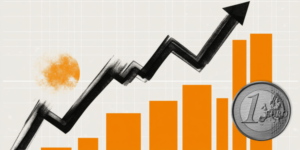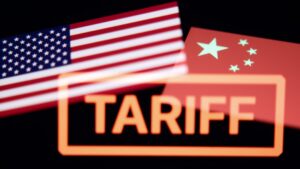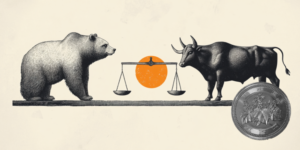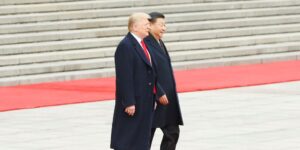The market analysts and so-called economists panicking over President Donald Trump’s tariffs must be at least somewhat relieved that he’s agreed to pause the ones he wants to impose on Mexico.
But they shouldn’t have been worried in the first place, because their fears are misplaced. Trump understands the harsh reality of the situation: other nations have exploited the U.S. for decades, and it’s long past time America fought back. In fact, Trump’s actions will benefit Americans greatly.
In the first place, the idea that tariffs are always and everywhere passed on to consumers is a fallacy, by both economic theory and the record of history. Factors such as changes in exchange rates mean that foreign producers typically end up paying some (or most) of a tariff.
HOW TRUMP’S TARIFFS CLOSED THE LOOPHOLE USED BY CHINESE RETAILERS
We forget that during America’s Golden Age, the government essentially funded itself entirely with tariffs; the income tax didn’t even exist. Instead of tariffs wreaking untold economic calamity, they coincided with our fastest sustained levels of growth—a time that built America’s middle class.
But today, both our friends and foes alike abuse America in international trade and undermine her potential to thrive. For example, Mexico has been working with China to circumvent tariffs and non-tariff barriers (NTBs) on China and abuse provisions of the trade deal between Mexico and Canada. That makes it impossible for American companies and American workers to compete.
Slapping a tariff on both Mexico and China penalizes this kind of underhanded dealing and puts American exporters back on a more level playing field. When asked about tariffs on the European Union, Trump said he’ll use the same playbook, and rightfully so.
MEXICO AGREES TO DEPLOY 10,000 TROOPS TO US BORDER IN EXCHANGE FOR TARIFF PAUSE
Many European nations use schemes like value added taxes (VATs) to impose implicit tariffs on American exports. Furthermore, countries like Germany and Japan still have tariffs that were put in place after World War II to protect industries being rebuilt following the conflict. The status quo has completely changed, and there’s no reason for these nations to continue penalizing American farmers and factoryworkers.
We finally have a president who recognizes these realities and who is implementing a carrot-and-stick approach to reshuffle the international paradigm in America’s favor. Trump is simultaneously making it more expensive to produce abroad and hire foreigners, while making it less expensive to produce domestically and hire Americans.
Deregulation, lower marginal tax rates, and abundant energy will all contribute to lower costs of production in the U.S. while tariffs will increase costs on overseas production. How does this play out?
CHINA THREATENS TO RETALIATE AGAINST TRUMP TARIFFS
Consider Canada, whose leaders are ranting about Trump standing up for Americans. If Canada agrees to eliminate its own tariffs and NTBs, then American exporters, like dairy farmers, will be more competitive and will sell more product in Canada. That means doing more business and employing more Americans.
If Canada remains obstinate and insists on a trade war, then Canadian products will be less competitive, opening the door for American producers, like foresters, to expand production and sell more domestically while employing more Americans. Trump is positioning the American worker to come out on top either way.
As economist Art Laffer has noted, there are no winners in trade wars, but the losers can face drastically different losses. Nearly all Canadian exports go to the U.S. but only a small fraction of American exports go to Canada. If international trade between the two slows dramatically, it’ll lead to a steep recession in Canada but will be more like a speed bump for the U.S.
TRUMP IMPOSES TARIFFS ON IMPORTS FROM CANADA, MEXICO AND CHINA: ‘NATIONAL EMERGENCY’
In short, Trump holds all the cards. And he knows it.
But it’s not just a matter of getting other nations to fully open their markets to American exporters; it’s about the trade deficit, which can’t go on forever. Economic textbooks sometimes explain away the deficit by pointing out that individuals often have steep trade deficits with retail stores, like Walmart or Amazon, and that doesn’t cause the individual to go bankrupt.
While that’s true, this singular trade deficit is only possible in the long run because the individual has a massive trade surplus somewhere else, like their place of employment.
America’s long-standing deficit has been funded by the Federal Reserve, which has effectively been printing money and sending it around the world to finance our elephantine trade deficits for decades. This process has devalued the dollar over the years, so that Americans’ money doesn’t go as far as it used to—a phenomenon we call inflation.
But the inflationary impact of our trade deficits has been blunted by the dollar’s status as the world’s reserve currency. If we suddenly lose that, however, America may face hyperinflation. That’s why Trump has threatened tariffs on countries that seek to dethrone King Dollar from its place in the world monetary order—a quick end to the dollar’s reserve currency status would be disastrous.
Lastly, Trump understands the misnomer of “free trade.” If we really want free trade, then why only advocate for it in international markets? Why not domestic transactions too? In other words, if taxes on international trade are so bad, then why do we allow taxes on domestic trade—like the income tax, which is a tax on labor?
Free trade should apply first and foremost to domestic trade because we should be focused on benefiting our own citizens before we worry about those overseas. We don’t hate foreigners—we just love Americans more.
E.J. Antoni, a public finance economist, is the Richard F. Aster fellow at the Heritage Foundation and a senior fellow at Unleash Prosperity.
Read the full article here
















